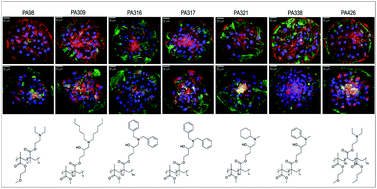当前位置:
X-MOL 学术
›
Biomater. Sci.
›
论文详情
Our official English website, www.x-mol.net, welcomes your feedback! (Note: you will need to create a separate account there.)
Acrylate-based materials for heart valve scaffold engineering†
Biomaterials Science ( IF 6.6 ) Pub Date : 2017-11-13 00:00:00 , DOI: 10.1039/c7bm00854f Rosaria Santoro 1, 2, 3, 4, 5 , Seshasailam Venkateswaran 6, 7, 8, 9, 10 , Francesco Amadeo 1, 2, 3, 4, 5 , Rong Zhang 6, 7, 8, 9, 10 , Maura Brioschi 2, 3, 4, 5, 11 , Anthony Callanan 8, 9, 10, 12, 13 , Marco Agrifoglio 4, 5, 14 , Cristina Banfi 2, 3, 4, 5, 11 , Mark Bradley 6, 7, 8, 9, 10 , Maurizio Pesce 1, 2, 3, 4, 5
Biomaterials Science ( IF 6.6 ) Pub Date : 2017-11-13 00:00:00 , DOI: 10.1039/c7bm00854f Rosaria Santoro 1, 2, 3, 4, 5 , Seshasailam Venkateswaran 6, 7, 8, 9, 10 , Francesco Amadeo 1, 2, 3, 4, 5 , Rong Zhang 6, 7, 8, 9, 10 , Maura Brioschi 2, 3, 4, 5, 11 , Anthony Callanan 8, 9, 10, 12, 13 , Marco Agrifoglio 4, 5, 14 , Cristina Banfi 2, 3, 4, 5, 11 , Mark Bradley 6, 7, 8, 9, 10 , Maurizio Pesce 1, 2, 3, 4, 5
Affiliation

|
Calcific aortic valve disease (CAVD) is the most frequent cardiac valve pathology. Its standard treatment consists of surgical replacement either with mechanical (metal made) or biological (animal tissue made) valve prostheses, both of which have glaring deficiencies. In the search for novel materials to manufacture artificial valve tissue, we have conducted a high-throughput screening with subsequent up-scaling to identify non-degradable polymer substrates that promote valve interstitial cells (VICs) adherence/growth and, at the same time, prevent their evolution toward a pro-calcific phenotype. Here, we provide evidence that one of the two identified ‘hit’ polymers, poly(methoxyethylmethacrylate-co-diethylaminoethylmethacrylate), provided robust VICs adhesion and maintained the healthy VICs phenotype without inducing pro-osteogenic differentiation. This ability was also maintained when the polymer was used to coat a non-woven poly-caprolactone (PCL) scaffold using a novel solvent coating procedure, followed by bioreactor-assisted VICs seeding. Since we observed that VICs had an increased secretion of the elastin-maturing component MFAP4 in addition to other valve-specific extracellular matrix components, we conclude that valve implants constructed with this polyacrylate will drive the biological response of human valve-specific cells.
中文翻译:

用于心脏瓣膜支架工程的丙烯酸酯基材料†
钙化主动脉瓣疾病(CAVD)是最常见的心脏瓣膜病理。它的标准治疗方法是用机械(金属制造)或生物(动物组织制造)瓣膜假体进行外科手术置换,两者均存在明显的缺陷。在寻找制造人造瓣膜组织的新颖材料时,我们进行了高通量筛选,随后进行了放大,以鉴定可降解的,可促进瓣膜间质细胞(VIC)粘附/生长并同时促进粘附的聚合物底物。阻止它们向钙化表型发展。在这里,我们提供的证据是,两个已确定的“命中”聚合物之一是聚(甲基丙烯酸甲氧基乙酯)-co-二乙基氨基乙基甲基丙烯酸酯)提供了牢固的VIC粘附力,并保持了健康的VIC表型,而没有诱导成骨细胞分化。当使用新型溶剂涂布程序将聚合物用于涂布非织造聚己内酯(PCL)支架时,再进行生物反应器辅助的VIC接种,也可以保持这种能力。由于我们观察到VIC除具有其他瓣膜特异性细胞外基质成分外,还增加了弹性蛋白成熟成分MFAP4的分泌,因此我们得出结论,用这种聚丙烯酸酯构造的瓣膜植入物将驱动人瓣膜特异性细胞的生物学反应。
更新日期:2017-11-13
中文翻译:

用于心脏瓣膜支架工程的丙烯酸酯基材料†
钙化主动脉瓣疾病(CAVD)是最常见的心脏瓣膜病理。它的标准治疗方法是用机械(金属制造)或生物(动物组织制造)瓣膜假体进行外科手术置换,两者均存在明显的缺陷。在寻找制造人造瓣膜组织的新颖材料时,我们进行了高通量筛选,随后进行了放大,以鉴定可降解的,可促进瓣膜间质细胞(VIC)粘附/生长并同时促进粘附的聚合物底物。阻止它们向钙化表型发展。在这里,我们提供的证据是,两个已确定的“命中”聚合物之一是聚(甲基丙烯酸甲氧基乙酯)-co-二乙基氨基乙基甲基丙烯酸酯)提供了牢固的VIC粘附力,并保持了健康的VIC表型,而没有诱导成骨细胞分化。当使用新型溶剂涂布程序将聚合物用于涂布非织造聚己内酯(PCL)支架时,再进行生物反应器辅助的VIC接种,也可以保持这种能力。由于我们观察到VIC除具有其他瓣膜特异性细胞外基质成分外,还增加了弹性蛋白成熟成分MFAP4的分泌,因此我们得出结论,用这种聚丙烯酸酯构造的瓣膜植入物将驱动人瓣膜特异性细胞的生物学反应。



























 京公网安备 11010802027423号
京公网安备 11010802027423号